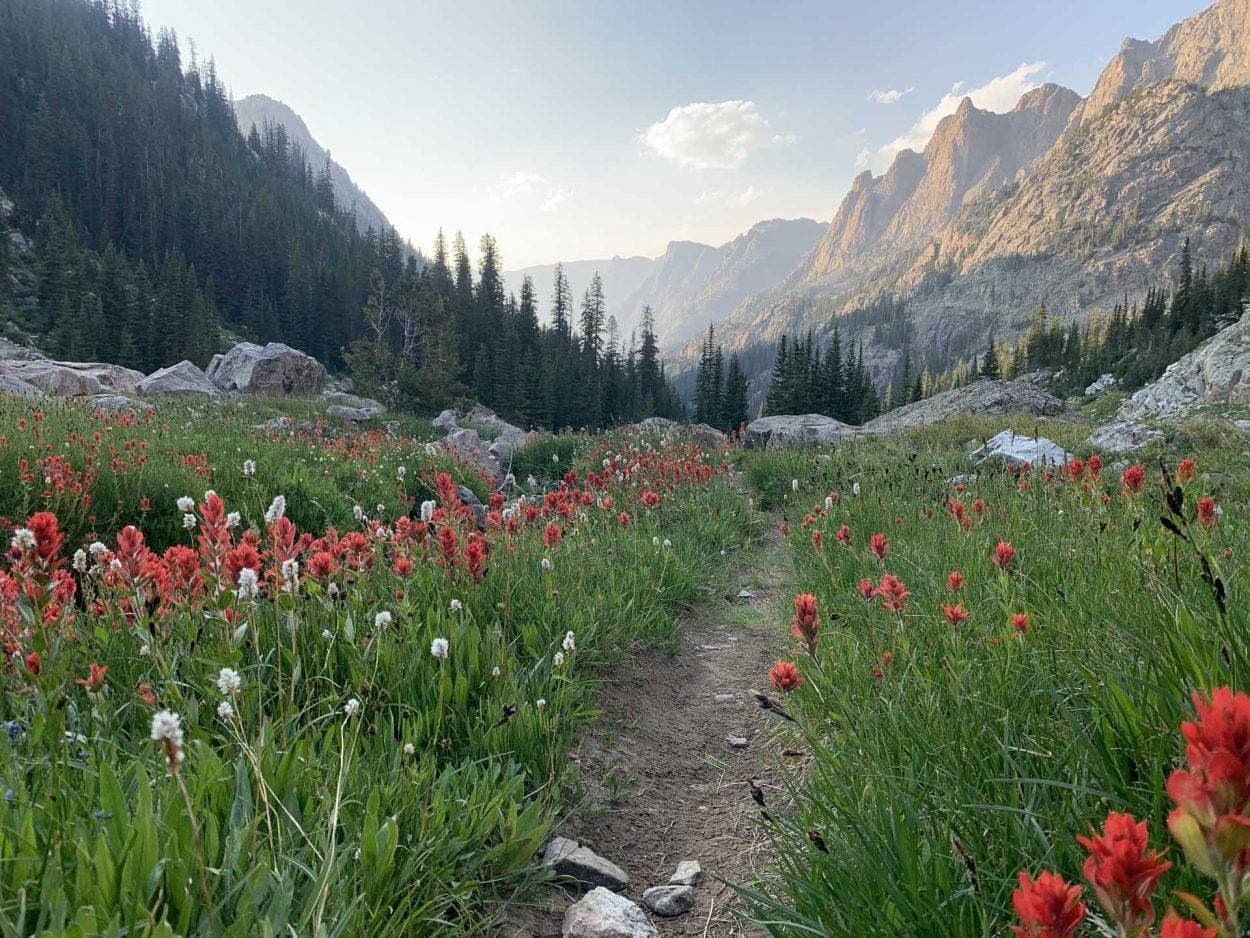The Continental Divide National Scenic Trail is far more than a path on the ground; rather, it is the sum of the scenic, natural, cultural, and historical qualities of the areas surrounding the trail that make a journey along the CDT unique and spectacular. The Continental Divide Trail is protected and maintained not only for the physical trail itself, but more importantly, for the experiences it provides.
Background
In 1966, the federal Trails for America study described the potential power of National Scenic Trails:
“The spirit of adventure springs ever anew in the hearts of Americans, young and old. In no way is it better satisfied than in the exploration of unfamiliar terrain or in the discovery of the beauties of nature. Long-distance trails can provide unparalleled opportunities for such adventure and such satisfaction.”
Two years later, in 1968, Congress created the National Trails System, “in order to provide for the ever-increasing outdoor recreation needs of an expanding population and in order to promote the preservation of, public access to, travel within, and enjoyment and appreciation of the open-air, outdoor areas and historic resources of the Nation.”
While the Continental Divide National Scenic Trail was included in the original Trails for America study, it was not designated in the National Trails System Act of 1968, and was instead recommended for further study. This study, which took almost a decade and involved federal land management agencies, the states of New Mexico, Colorado, Wyoming, Idaho, and Montana, and numerous private organizations and individuals, culminated in the 1976 Continental Divide Trail Study Report. While this document does not have the force of law or policy, it remains the most comprehensive examination of what the Continental Divide National Scenic Trail could and should be, and as such, its contents are invaluable in defining the Continental Divide Trail experience.

Findings from the 1976 Continental Divide Trail Study Report that we have found particularly useful in defining the CDT experience are as follows:
- “The primary purpose of this trail would be to provide a continuous, appealing trail route, designed for the hiker and horseman, but compatible with other land uses.” (p. 1)
- “Trail users would wind their way through some of the most spectacular scenery in the United States and have an opportunity to enjoy a greater diversity of physical and natural qualities than found on any other extended trail. The route of the Continental Divide Trail would cross five ecological life zones where visitors would find much of the topography, climate, vegetation and wildlife for which the Rocky Mountain West is noted.” (p. 4)
- “The areas through which the trail would pass are also rich in the heritage and life of the Rocky Mountains and the southwestern United States. The trail traverses lands of historical and cultural importance. It would provide the recreationist with examples of past periods of American development, examples of the many ways in which we now use our lands, as well as ways in which we could make better use of our resources through public awareness and appreciation of environmental relationships and good resource management practices.” (p. 4)
- “The trail experience could range from an hour’s outing to several weeks and from one mile to several hundred. The trail would open up a broad spectrum of terrain and opportunity, from strenuous backpacking to leisurely strolling.” (p. 4)
- “A trail attempting to hold to the actual spine of the Continental Divide would be totally undesirable due to its hazardous character, narrow recreation appeal, extremely high costs, and because of the gross alteration of the natural environment which such an alignment would necessitate. It was thus concluded that the most suitable route for a trail – still befitting its name – would be as close to the Continental Divide as circumstances permit but as far away as necessary to provide a safe trail which could be environmentally and economically justified and which would possess a general recreation appeal.” (p. 6)
- “The trail experience on or near the Divide is an intimate one, for one can walk or ride horseback across vast fields of wildflowers and contemplate a story dating from the dawn of earth’s history. This story began when a portion of the earth was thrust upward, creating the sharp precipitous peaks that were sculptured into rich landforms leaving sparkling lakes, crystal-clear streams, and myriads of cascading waterfalls. Along the way, the tranquility of the alpine meadows, verdant forests and semi-desert landscape overwhelms everyone who passes that way.” (p. 18)
- “Only a very small percentage of the total use of the Continental Divide Trail is expected to come from people attempting to hike or ride it in entirety, and such use should therefore not be considered a principal justification for its designation as a National Scenic Trail. Nevertheless, a continuous travelway from Canada to Mexico would lend an aura to the trail impossible to obtain otherwise.” (p. 56)
Additionally, the Comprehensive Plan for the Continental Divide National Scenic Trail, most recently amended in 2009, describes the nature and purposes of the trail:
“The nature and purposes of the CDNST are to provide for high-quality scenic, primitive hiking and horseback riding opportunities and to conserve natural, historic, and cultural resources along the CDNST corridor.”
It is important to note that the Comprehensive Plan states that part of the purpose of the trail itself is to conserve resources along its corridor.

Defining the Continental Divide Trail Experience
CDTC draws great inspiration from those who first envisioned the Continental Divide National Scenic Trail, while envisioning a future more just and equitable than our past, in which our National Trails System reflects and respects the history of all cultures, and actively engages all people. As such, we define the CDNST experience as follows:
A continuous travelway from Canada to Mexico, the Continental Divide National Scenic Trail is designed primarily for hikers and horseback-riders, though other non-motorized uses may be allowed in some areas. In each area it traverses, the trail is developed to the minimum standard to provide optimal outdoor recreation opportunities and to minimize the impact of the trail on the natural environment, and located as close to the geographic Continental Divide as is environmentally and economically feasible. Along its length, the Continental Divide Trail experience reflects the surrounding landscape, in some areas providing access to seemingly unending mountain ranges with no present-day human influence in sight, and in others passing through the heart of small Western towns. The trail offers up a broad spectrum of terrain and opportunity, from strenuous backpacking to a pleasant walk in nature, and the visitor’s experience can range from an hour’s outing to several weeks of near isolation.

The Continental Divide Trail stretches more than 3,100 miles along the Continental Divide of the Americas, where the great rivers of our nation originate. It winds its way through some of the most spectacular scenery in the United States, from high-alpine tundra to lush forests, meadows dotted with wildflowers and deserts painted red by the setting sun. The Continental Divide Trail travels through the homelands of more than a dozen Native American tribes, who have cared for and connected with the Divide for thousands of years. It connects ghost towns of centuries past with vibrant small communities, ranches, and farmsteads of the present. It traverses incredible ecosystems home to diverse plants and animals, providing corridors for migrations, and passing by many species that are uniquely endemic to the Rocky Mountain West, the sky islands of the Chihuahuan desert, and the high desert of New Mexico.
The Continental Divide Trail is, in its purest form, an entryway to the wide and varied landscapes of the Divide, providing access to and new understandings of local scenic, cultural, historic, and natural treasures and places.. The trail is protected for the preservation, enjoyment, and appreciation of the resources along its length, and it provides all of us with a means to connect with friends,family, and community draw inspiration, and create outstanding personal and interpersonal experiences.
The Continental Divide Trail experience, then, represents not just the trail itself, but the multitude of opportunities and experiences available for those visiting the trail to interact with the lands and waters surrounding it, including:
- Spectacular, sweeping views of undeveloped landscapes, including forests, alpine tundra, deserts, meadows, mountain peaks, river valleys, and rolling plains;
- A sense of being on the spine of North America, the origin of the nation’s waters;
- A welcoming space for people of all races, abilities, ethnicities, backgrounds, , and sexual and gender orientations to access the healing powers of nature and connection to something greater than oneself;
- Heightened connections to friends, family, and community, strengthened through shared experience;
- The histories and stories of the first inhabitants of the land, with recognition that many areas the trail traverses are sacred to the various nations of Native Americans who live or have lived along its length;
- Protected ecosystems that link diverse aquatic and terrestrial habitats along the length of the trail;
- Immersion in the natural environment and a feeling of connection to the plants and animals of the Divide;
- The trail itself as a mark of the dedication of those who built and sustain it;
- The cultural heritage of the West, from the historic trade routes of Native Americans to mining boom towns to present-day rural communities and ways of life along the Divide;
- Physical and mental challenge through self-reliance;
- Extended, slow-paced journeys on foot or horseback;
- Feelings of solitude and opportunities for reflection, particularly in designated wilderness areas;
- A sense of pride in the trail and its surroundings;
- Becoming a part of a grassroots community dedicated to stewarding and protecting this experience for future generations.
The Continental Divide Trail experience is paramount in all of our efforts to protect, promote, and ensure the stewardship of the CDT. As such, this statement serves as the foundation for all organizational policies related to management of the trail.




